
What is echolocation? Definition and examples
what echolocation means: a biological form of sonar, this process uses sound waves reflected back to the emitter (ie, echoes) to create a mental map of its surroundings.
A physiological technique, echolocation can be used for orientation, to avoid obstacles, hunt prey, and in social interactions.
The following animal species utilize the system:
- The majority of bats, so that they can fly at night – a skill which likely developed to allow them to hunt nocturnal insects (a niche left unoccupied by the majority of birds)
- Most toothed whales (AKA odontocetes, a group which also includes dolphins and porpoises), in order to hunt in muddy water or deep-sea darkness; they are able “to work out an object’s distance, direction, speed, density and size”. These species’ echolocation pulses are so loud that their ears are shielded for protection
- Some shrew species
- Just two types of bird: the nocturnal South American oilbird, and some Southeast Asian cave swiftlets.
All of these animals give off sounds which, when bounced back by obstructions, or by prey, can provide a non-visual interpretation of the environment. Echolocation pulses may vary from around 1,000 hertz (birds) to 200,000 Hz (whales), while different bats’ frequencies vary from 11,000 to 212,000 Hz. The rate of pulses differ according to circumstances, from around one per second to “several hundred per second (e.g., in a bat close to its target)”.
Convergent evolution – the independent development of traits in response to similar circumstances – means that particular species of toothed whales and bats possesses an almost identically mutated protein. Called prestin, its presence increases the animals’ high-frequency sensitivity, heightening their ability to detect the return echoes of their echolocation pulses.
It is also possible for humans to echolocate. This mostly applies to people blind from birth; though not without limits, understanding how this is done could lead to other non-sighted people being taught to use the process. In humans, the technique involves making clicking noises with the mouth or by snapping the fingers. New Scientist states that some individuals “are so proficient they can draw a sketch of a room after clicking their way around it, or even go mountain biking along unfamiliar routes”. One such individual, Daniel Kish, reports experiencing information received through echolocation almost as images, with “a real palpable experience of the image as a spatial representation – here are walls, here are the corners, here is the presence of objects.”
While it has been previously established that human echolocation shares some of the brain areas used by sighted people in relation to vision, a recent study carried out by Lore Thaler at Durham University, UK, has shed new light on the process (see here and here). By working with Kish and two further echolocators, Thaler’s team have created a system of synthetic clicks which can be used for continued research, for example, into the most effective type of click for a particular situation.
The clicks deployed by Kish and the other echolocators take “the form of highly focused sound waves emitted in a 60-degree cone, compared with 120 to 180 degrees for typical speech”; this cone is unconsciously directed towards the area they are attempting to perceive. The clicks themselves last just three milliseconds, possibly to stop individual clicks from overlapping with the returning echoes.
As well as being beneficial for people with sight loss, this area of research could improve artificial sonar in ways that may be applicable to self-driving cars – especially since human echolocators’ perception can be nuanced enough to even establish “the true size of a range of objects placed at different distances”.
Earth.fm is a completely free streaming service of 1000+ nature sounds from around the world, offering natural soundscapes and guided meditations for people who wish to listen to nature, relax, and become more connected. Launched in 2022, Earth.fm is a non-profit and a 1% for the Planet Environmental Partner.
Check out our recordings of nature ambience from sound recordists and artists spanning the globe, our thematic playlists of immersive soundscapes and our Wind Is the Original Radio podcast.
You can join the Earth.fm family by signing up for our newsletter of weekly inspiration for your precious ears, or become a member to enjoy the extra Earth.fm features and goodies and support us on our mission.
Subscription fees contribute to growing our library of authentic nature sounds, research into topics like noise pollution and the connection between nature and mental wellbeing, as well as funding grants that support emerging nature sound recordists from underprivileged communities.
